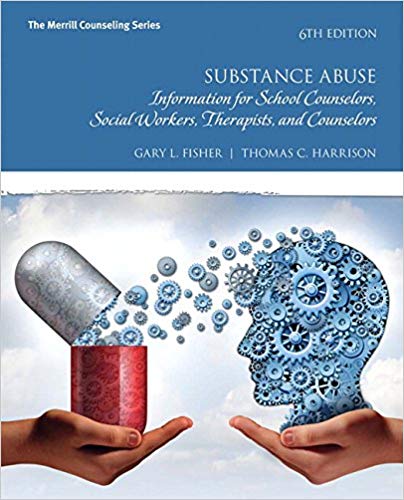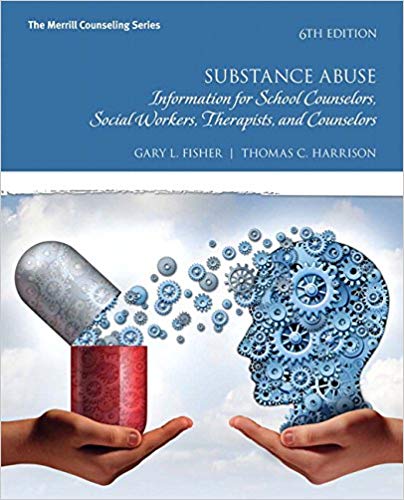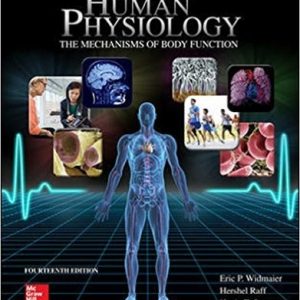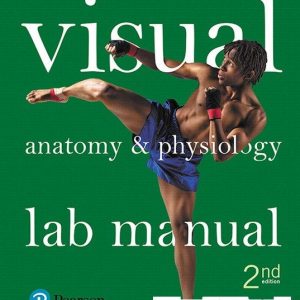This is completed downloadable of Test Bank for Substance Abuse: Information for School Counselors, Social Workers, Therapists, and Counselors (6th Edition) 6th Edition

Product Details:
- ISBN-10 : 9780134387642
- ISBN-13 : 978-0134387642
- Author:
In an accessible writing style, Fisher and Harrison’s Substance Abuse: Information for School Counselors, Social Workers, Therapists and Counselors presents succinct, practical coverage of alcohol and other drug prevention, treatment, and recovery for generalist students, prospective mental health professionals, and allied professionals. It includes basic information on substances of abuse and focuses on clinically relevant knowledge on such topics as cultural competence, co-occurring disorders, other behavioral addictions, children and families, and ethics and confidentiality. Each chapter includes clinical application cases and questions for further discussion. The new edition inclues a new chapter on “Co-Occurring Disorders and Other Special Populations,” new information on cultural competencies and intervening with special populations such as the elderly and LGBTQQI, and new information on risk factors for alcohol and other drugs for culturally and ethnically diverse populations.
Table of Content:
- Chapter 1 The Role of the Mental Health Professional in Prevention and Treatment
- The Need for Generalist Training
- Philosophical Orientation
- Professional Orientation
- Attitudes and Beliefs
- Denial, Minimization, Projection, and Rationalization
- Helping Attitudes and Behaviors
- Overview of the Book
- Chapter 2 Classification of Drugs
- Comprehensive Drug Abuse Prevention and Control Act
- The Concept of Dangerousness
- Definitions
- The Neurobiology of Addiction1
- Central Nervous System Depressants
- Drugs in This Classification
- Routes of Administration
- Major Acute and Chronic Effects
- Overdose
- Tolerance
- Withdrawal
- Central Nervous System Stimulants
- Drugs in This Classification
- Routes of Administration
- Major Acute and Chronic Effects
- Overdose
- Tolerance
- Withdrawal
- Opioids
- Drugs in This Classification
- Routes of Administration
- Major Acute and Chronic Effects
- Overdose
- Tolerance
- Withdrawal
- Hallucinogens
- Drugs in This Classification
- Routes of Administration
- Major Acute and Chronic Effects
- Overdose
- Tolerance
- Withdrawal
- Cannabinols and Synthetic Cannabinols
- Drugs in This Classification
- Routes of Administration
- Major Acute and Chronic Effects
- Overdose
- Tolerance
- Withdrawal
- Inhalants and Volatile Hydrocarbons
- Drugs in This Classification
- Route of Administration
- Major Acute and Chronic Effects
- Overdose
- Tolerance
- Withdrawal
- Anabolic Steroids
- Drugs in This Classification
- Routes of Administration
- Major Acute and Chronic Effects
- Overdose
- Tolerance
- Withdrawal
- Club Drugs
- Drugs Used in the Treatment of Mental Disorders
- Drugs Used in the Treatment of Psychotic Disorders
- Drugs Used in the Treatment of Affective Disorders
- Drugs Used in the Treatment of Attention Deficit Disorder
- Summary
- Additional Reading
- Internet Resources
- Further Discussion
- Chapter 3 Models of Addiction
- The Moral Model
- Sociocultural Models of Addiction
- Psychological Models of Addiction
- Disease Concept of Addiction
- Evidence to Support the Disease Concept
- Critics of the Disease Concept
- Advantages of the Disease Concept
- Disadvantages of the Disease Concept
- Biopsychosocial Model of Addiction
- Summary
- Internet Resources
- Further Discussion
- Chapter 4 Culturally and Ethnically Diverse Populations
- Native Americans and Alaska Natives
- Background
- Values
- Time
- Humans, The Natural World, and Social Relationships
- Noninterference
- Risk Factors for Alcohol and Other Drug Abuse
- Psychosocial Factors
- Behavioral Risk Factors
- Asian Americans and Pacific Islanders
- Background
- Values
- Family Roles
- Communication
- Religion
- Risk Factors for Alcohol and Other Drug Abuse
- African Americans
- Background
- Values
- Family Roles
- Kinship and Extended Family Bonds
- Religion
- Risk Factors for Alcohol and Other Drug Abuse
- Developmental Issues
- Latino and Hispanic Populations
- Background
- Values
- Family and Caring
- Gender Roles
- Risk Factors for Alcohol and Other Drug Abuse
- Sociological Risk Factors
- The Elderly, Disabled, and Sexual Minority Populations
- Risk Factors for Alcohol and Other Drug Abuse
- Helping Culturally and Ethnically Diverse Populations
- Issues for the Helping Professionals
- Assessment and Treatment Issues
- Working with Native Americans
- Working with Asian Americans/Pacific Islanders
- Working with African Americans
- Working with Latinos and Hispanics
- Working with Elderly Populations
- Working with Lgbtqqi Populations
- Sensitivity to Multicultural Issues
- Summary
- Internet Resources
- Further Discussion
- Chapter 5 Confidentiality and Ethical Issues
- Confidentiality: 42 Code of Federal Regulations, Part 2 (42 CFR)
- Does 42 CFR Apply to You?
- The General Rule
- Written Consent
- Other Exceptions to the General Rule
- Other Confidentiality Issues
- Confidentiality and School Counseling
- Health Insurance Portability and Accountability Act (HIPAA)
- Drug Testing
- Documentation
- Ethics
- Scope of Practice
- Client Welfare
- Managed Care
- Application of Confidentiality Regulations
- Summary
- Internet Resources
- Further Discussion
- Chapter 6 Screening, Assessment, and Diagnosis
- Definitions of Use, Misuse, Abuse, and Dependence or Addiction
- Screening
- Psychosocial History
- AOD Use History
- Family History
- Social History
- Legal History
- Educational History
- Occupational History
- Medical History
- Psychological and Behavioral Problems
- Signs of Adolescent Substance Abuse
- Self-Report Inventories
- Michigan Alcohol Screening Test
- CAGE
- Alcohol Use Disorders Identification Test
- Problem-Oriented Screening Instrument for Teenagers
- Addiction Severity Index
- Referral
- Diagnosis
- The Diagnostic and Statistical Manual of Mental Disorders, Fifth Edition (DSM-V)
- Summary
- Internet Resources
- Further Discussion
- Chapter 7 Motivational Interviewing and Brief Interventions
- Client Engagement
- Motivational Interviewing
- Four General Principles of MI
- Ambivalence
- Eliciting Change Talk
- Client Resistance and Counselor’s Behavior
- Transition from Resistance to Change
- MI and Stages of Change
- MI Applications to Case Examples
- Research Outcome Studies
- Brief Interventions
- Summary
- Internet Resources
- Further Discussion
- Chapter 8 Treatment of Alcohol and Other Drugs (AOD)
- Recovery-Oriented Systems of Care
- How Many Are in Treatment? How Many Need Treatment?
- What Happens in Treatment?
- Approaches to Treatment
- Treatment Strategies and Techniques
- Example of Treatment Plan
- Individual, Group, and Family Counseling
- Support Groups
- Lifestyle Changes
- Education
- Aftercare
- Treatment Settings
- Choice of Treatment Setting
- Therapeutic Communities
- Inpatient and Residential Treatment
- Partial Hospitalization and Day Treatment
- Intensive Outpatient and Outpatient
- Principles of Effective Treatment
- Evidence-Based Treatment
- Case Example Applications
- Treatment Effectiveness
- Special Problems in Treatment
- Recovering Individuals as Counselors
- Confrontation as a Treatment Strategy
- The Use of Medication
- Controlled Use
- Natural Recovery
- Summary
- Internet Resources
- Further Discussion
- Chapter 9 Co-occurring Disorders and Other Special Populations
- Definitions
- Prevalence
- Types of COMD
- Treatment
- Other Special Populations
- Ethnically Diverse Populations
- Elderly
- Adolescents
- Persons with Disabilities
- Women
- Lesbian, Gay, Bisexual, and Transgender Individuals
- Criminal Justice Populations
- Summary
- Internet Resources
- Further Discussion
- Chapter 10 Relapse Prevention and Recovery
- Need for Generalist Training in Relapse Prevention
- Definitions of Slip and Relapse
- Frequency of Slips and Relapses
- Is Relapse in Addiction Similar to Other Chronic Conditions?
- Models of Relapse Prevention
- The Cenaps Model
- A Cognitive-Social Learning Model
- Essential Components of Relapse Prevention
- Assessment of High-Risk Situations
- Coping with High-Risk Situations
- Support Systems
- Lifestyle Changes
- Leisure Time
- Support Systems
- Social and Communication Skills
- Self-Care
- Educational and Vocational Guidance
- Financial Planning
- Relationships
- Balance
- Preventing Slips from Escalating
- Recovery
- Recovery Support Services
- Recovery and Spirituality
- Summary
- Internet Resources
- Further Discussion
- Chapter 11 Twelve Step and Other Types of Support Groups
- Alcoholics Anonymous
- History of AA
- What AA Is About
- The Twelve Steps and the Twelve Traditions
- The Twelve Steps1
- The Twelve Traditions2
- Elements of AA Meetings
- Research on AA
- AA and Spirituality
- Misconceptions Regarding AA
- Other Twelve Step Groups
- Advantages and Disadvantages of Twelve Step Groups
- Other Types of Support Groups
- Many Roads, One Journey
- Women for Sobriety
- Secular Organizations for Sobriety/Save Our Selves (SOS)
- Moderation Management
- Smart Recovery®
- Case Example Applications
- Summary
- Internet Resources
- Further Discussion
- Chapter 12 Children and Families
- Family Structure and Dynamics
- Homeostasis
- Subsystems and Boundaries
- The Marital or Couple Subsystem
- The Parent–Child Subsystem
- Roles
- Family Roles
- Childhood Roles
- Family Rules
- Children’s Exposure to AOD
- Prenatal Exposure to Alcohol and Other Drugs
- Impact of Fetal Exposure to Aod
- Neonatal Abstinence Syndrome
- Interpersonal Exposure to Alcohol and Other Drug Abuse
- Methamphetamine
- Family Exposure to Alcohol and Other Drugs
- Nontraditional Families and Special Populations
- Women and Alcoholism
- Assessment of Problems in Women
- Treatment Concerns for Women
- Helping Families
- Underlying Family Themes
- Spirituality
- Recovery and Reintegration in the Family
- Barón’s Integrative Cross-Cultural Model
- Case Example
- Kaufman and Kaufman’s Family Types
- Summary
- Internet Resources
- Further Discussion
- Chapter 13 Adult Children and Codependency
- ACOAs
- Clinical Characteristics and Empirical Research
- Risk Factors
- Assessment and Treatment Considerations
- Assessment of ACOAs
- Implications for Intervention
- Codependency
- Definitions of Codependency
- Characteristics of Codependent Individuals
- Assessing for Codependency
- Phases of Codependency
- Implications for Mental Health Professionals
- Mental Health Professionals’ Own Codependency
- Professional Enabling and Transference/Countertransference
- Relationship of ACOA, AA, Al-Anon, and Codependency
- Critics of the ACOA–Codependency Movement
- Popular Criticism
- Professional Criticism
- Codependency and Diversity
- Feminist Critiques of Codependency
- Gender Bias
- The Codependency Discourse
- Victimization and Victimhood
- Relationship Between Social Oppression and Codependency
- Summary
- Internet Resources
- Further Discussion
- Chapter 14 HIV/AIDS
- Incidence and Prevalence
- HIV and AIDS
- Stages
- Stages of Development
- Stage One: Acute Infection.
- Stage Two: Clinical Latency.
- Stage Three: AIDS.
- Testing for HIV
- Transmission of HIV
- Coinfection: HIV Infection and Other Diseases
- High-Risk Groups
- Women
- Culturally and Ethnically Diverse Populations
- Adolescents
- Other High-Risk Groups
- Those in the Penal System
- The Homeless
- People with Disabilities and Older Adults
- Assessment of Clients for HIV and AIDS: Signs and Symptoms
- Physical Signs and Symptoms
- Helping HIV-Infected Clients
- Psychosocial Concerns of HIV-Infected Clients
- Emotional Concerns
- Medical Concerns
- Issues in the Workplace
- HIV-Related Issues Specific to the Helping Professional
- Disclosure Laws and Confidentiality
- Needle Exchange
- Summary
- Internet Resources
- Further Discussion
- Chapter 15 Gambling and Other Behavioral Addictions
- Prevalence of Gambling and Gambling Problems
- Definitions of Gamblers and Problem Gambling
- Other Behavioral Addictions
- The Debate over Behavioral Addictions
- The Eating Disorders
- Chronic Obesity
- Binge-Eating Disorder
- Bulimia Nervosa and Anorexia Nervosa
- Bulimia Nervosa
- Anorexia Nervosa
- Addiction to Sex and Love
- Internet Addiction
- Cyberaffairs
- Impact of Internet Abuse on Relationships, Students, and Workers
- Addiction to Work: Workaholism
- Structure of Workaholism
- Assessment and Treatment Issues
- Gambling
- Assessment and Diagnosis
- Treatment, Resources, and Support
- Resources
- Support
- Treatment of Other Behavioral Addictions
- Assessment and Diagnosis
- Eating Disorders
- Addiction to Sex and Love, the Internet, and Work
- Treatment
- Eating Disorders
- Addiction to Sex and Love
- Addiction to The Internet
- Addiction to Work
- Summary
- Internet Resources
- Further Discussion
- Chapter 16 Prevention
- Why are Prevention Efforts Needed?
- Policy Issues in Prevention
- Drug Free?
- Gateway Drugs
- Supply versus Demand
- Legalization
- Prevention Classification Systems
- The Institute of Medicine Classification System
- Classification by Prevention Strategy
- Information Dissemination
- Education
- Alternatives
- Problem Identification and Referral
- Community-Based Processes
- Environmental Approaches
- Classification by Risk and Protective Factors
- What Works in Prevention
- Evaluation of Prevention Programs
- Information Dissemination
- Education
- Alternatives
- Problem Identification and Referral
- Community-Based Processes
- Environmental Approaches
- Case Example Applications
- Evidence-Based Prevention
- Prevention Resources
- Prevention Specialists
- Summary
- Internet Resources
- Further Discussion
- References
- Credits
- Index
- A
- B
- C
- D
- E
- F
- G
- H
- I
- J
- K
- L
- M
- N
- O
- P
- Q
- R
- S
- T
- U
- V
- W
- Y
- Z





